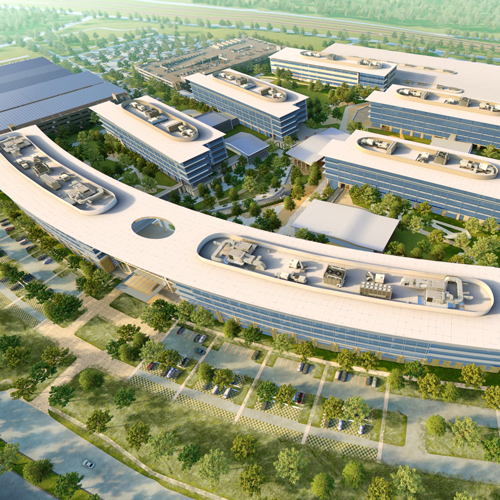The time is right for the WELL Building Standard. Employers are increasingly aware of the costs of employee turnover and absenteeism, and they know they bear some responsibility for that. Still, the healthy workplace standard is relatively new and faces some hurdles before it achieves widespread recognition. For now, it isn’t near the broad degree of adoption that the LEED certification has achieved.
Nevertheless, there are reasons to expect that WELL is on its way. Tracey Kasper—vice president of project management at the Morristown, New York, headquarters of Avison Young (AY)— sees this in her work, where clients increasingly opt for natural daylight, health and wellness programs, and environments that provide incentives to be active. Kasper notes that several of these features fit neatly with open-office, collaboration-fostering trends in facilities planning that meet the changing needs of the workforce and are also believed to enhance productivity and employee satisfaction.
The WELL Standard was launched in 2014 and has registered more than 200 projects with a cumulative 45 million square feet in 21 countries. Administered by the International WELL Building Institute (IWBI), a public benefit corporation, WELL looks at seven factors that impact occupant health: air quality; water quality and availability; nourishment (through healthier food choices and knowledge); lighting in sync with the body’s circadian rhythms; fitness and active-living design; comfort with distraction-free environments; and mental and emotional health supported by design and technologies.
As with the LEED program, there is a cost for certification. A consultant to AY, Michelle Cottrell-Raigosa (IIDA, LEED AP) of Design Management Services in South Florida and New Jersey, echoes what Kasper says about the WELL benefits.
“There are many benefits that can be measured,” says the designer and author of study guides for LEED-accreditation exams, and who herself is studying to be WELL-accredited. “WELL workplace employees have fewer sick days, turnover is reduced, and they enjoy better ergonomics and biophilia benefits that incorporate nature into offices.”
AY is a multinational commercial real estate services company that is historically based in Canada, but has opened 52 offices throughout the United States in the past seven years.
Kasper joined the company in 2012 and was part of the leadership that established the firm’s Global Citizenship initiatives, which formalized the company’s sustainability, social responsibility, and philanthropy strategies—each of which has a relationship with AY’s own employee and client bases. From this effort, she says she has a clear appreciation for what WELL can achieve, and it’s an early part of the discussion in client engagements. Thus far, however, the solutions devised only approximate what WELL encourages without formal completion of the certification process.
“Since employees are among organizations’ largest assets—especially those that are service based—health and well-being have become huge considerations,” Kasper says. “And there are financial considerations.”
When asked, for example, about installing attractive open staircases in multilevel workplaces to promote internal mobility, Kasper is pragmatic. “Those can easily cost $150,000 to $200,000,” she says, adding that a budget-conscious client can upgrade an existing fire stairwell as a reasonable alternative.
According to research from the Integrated Benefits Institute, absenteeism and productivity losses due to worker illness and disability cost the US economy $576 billion per year. Of that, 39 percent ($227 billion) is believed to be due to what they call “presenteeism,” when employees report to work while ill and are consequently less productive.
Kasper adds that different clients’ economic factors relate in different ways to the ideals and objectives of WELL, even if actual certifications are slow in arriving.
“Smaller, privately owned companies are more restricted in what they can spend,” she says. For them, leases tend to be shorter (five to seven-and-a-half years versus the 10–15-year leases that typify larger corporate tenancies), a factor which often translates into lower-cost build-outs.
“Those can be more challenging and require more creativity, but don’t preclude the creation of healthier environments,” she says, and adds that most materials, furniture, fixtures, and equipment are now made to be sustainable and friendly to human health, particularly where building codes require it. In order for products to remain relevant, they have to show sustainable solutions.
“Also, furniture reuse if possible is a very sustainable practice that allows for spending in other areas of the project,” Kasper says, and adds that furniture and materials manufacturers are going green because the markets demand it. “What has changed is how clients now better appreciate that the workplace affects their employees and the associated costs.”
AVISON YOUNG AT HEART
In her work with Avison Young (AY), Tracey Kasper has helped finesse smart leases and build-outs that are flexible to commercial tenants’ needs for both cost containment and growth. Here are three recent projects that exemplify the firm’s core expertise.
1. Jet.com, a rising competitor to Amazon, has its headquarters space in Hoboken, New Jersey. The AY-led project is being built out in three phases over three years. With an open-plan design that enables greater flexibility and mobility—what the client emphatically requested—the company can take on associated leasing costs gradually as its own operations ramp up. Additionally, planners learn from each phase to refine the next.

2. A similar approach is being taken by a new assignment for the AY Project Management group. This 350,000-square-foot lease commitment will also grow in phases over a four-year period. Each phase will gauge how business and human requirements are met, identifying areas for improvement.
3. Elsewhere in New Jersey, AY is helping a law firm with a 150,000-square-foot office build-out to create a pro-worker environment of open offices, natural daylighting, and views for all employees, while still providing private offices for attorneys. Features include full-front clear-glass windows, a 3,000-square-foot “collaborative hub” common area, concrete floors, and a mix of working environments—all of which are considered beneficial to talent recruitment, interdisciplinary interaction, employee wellness, and productivity.



